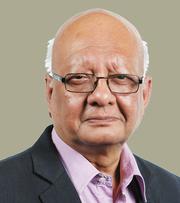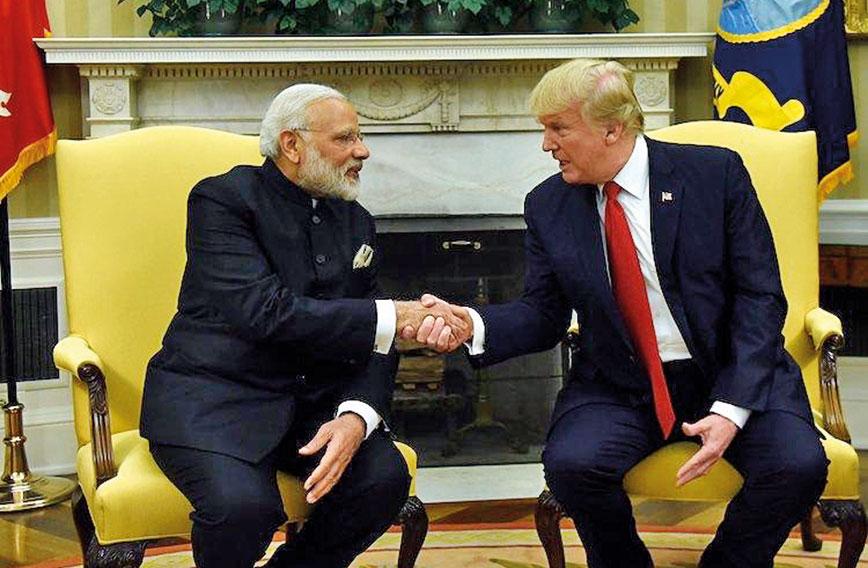
AMIT DASGUPTA
President Donald Trump recently made headlines, yet again. This time he criticised ‘friend and ally’ India on something that sounded insignificant and yet struck at the core of how foreign policy is being reinvented. Other than by the Americans.
In Trump’s view, Indian assistance for building a “library” in Afghanistan was a colossal waste of resources, both time and money. What he had hoped for was direct Indian military involvement in the actual fight against terrorism.
It is worth recalling that over decades, in several countries, the instruments of foreign policy have undergone a radical transformation, including in some instances, the replacement of traditional diplomacy, as we have known it.
In general terms, foreign policy is defined as the pursuance of one’s strategic national interests through negotiation, winning friends, and avoiding, as far as possible, conflict or war. Following the Westphalian model, diplomacy emerged as the principal instrument through which this was achieved.
It was and continues to be a strong and successful model where professional diplomats are used to championing or pushing the national agenda.
However, there are historical examples where this instrument has been tweaked to achieve a similar objective more effectively. Governments have, for instance, hand-picked emissaries and able negotiators, outside the formal diplomatic corps, to defuse crises. Or even used a different instrument to reach the same audience and achieve its stated objectives. Often, this had huge security and other ramifications.
Robert Kennedy’s secret negotiations with Anatoly Dobrynin, for instance, to end the Cuban missile crisis in 1962 peacefully, is well documented. The negotiations successfully defused a crisis that had all the makings of triggering World War III. On 17 different occasions, Mahatma Gandhi effectively opted for fasting as an instrument of civil disobedience and satyagraha rather than open confrontation — another powerful example where he either quelled rioting mobs or brought combative negotiators to the discussion table.
Such instances, nevertheless, remained within the overall rubric of traditional diplomacy with successful alternative and tweaked approaches.
A shift occurred when the focus on the interlocutor underwent a dramatic change. Traditional diplomacy was essentially an engagement between governments and their stated interlocutors. The public was largely kept out. But when the public or the ‘common man’ became the target of diplomacy, the game underwent a massive and transformative overhaul. India’s "library" in Afghanistan is one such example and a powerful one at that.
As indeed is the relatively little-known 800-year-old Indian hospice in Jerusalem, which was started by an Indian sufi, Baba Farid, who went there from Punjab, a decade or so after Saladin forced the Crusaders out of the holy city. For the thousands of Indian and other Muslims, who have sought and continue to seek shelter for the night during their pilgrimage to Mecca, this is a strong symbol of India in Jerusalem. No traditional diplomacy could ever match the impact this hospice has had on the common people. New Delhi recognises this and has, consequently, supported its upkeep financially. For Trump, this would be a waste of useful resources.
The synagogues of Kolkata, for instance, have been tended to by Muslim families over decades. For over half a century, a Muslim family has been carving headstones for one of India’s oldest cemeteries for the dwindling Bene Israel Jewish community in Mumbai. Such instances break the myth and perception that Muslims and Jews, as both a religion and a community, are incompatible. Telling such stories has now become a foreign policy instrument.
Over three decades ago, Joseph S. Nye spoke of ‘soft power’ as an alternative to ‘hard’ or military power. The latter, in his view, tended to achieve objectives through military operations and coercion, which would never truly have long-term acceptance. Soft power, on the other hand, "would get others to do what they would otherwise have not." In other words, hard power was meant to threaten and coerce governments, whereas soft power aimed at winning friends and influencing people outside of government. Over time, this became an additional and effective addition to the instruments of foreign policy, as governments across the globe reached out to people in addition to governments.
Several other developments took place during this time. Communications dramatically improved and this impacted the media and its reportage. Its multiplier effect was felt across geographies that went beyond democracies. The Arab Spring, for instance, was people-driven and against what were perceived as oppressive regimes. It started in Tunisia and rapidly spread to Libya, Egypt, Yemen, Syria and Bahrain. Government forces understandably cracked down on protesters but, as history demonstrated, governments fell and regimes changed, ushering in greater consultations with people and a more democratic form of governance.
Governments, across the globe, have increasingly come to recognise civil society as an integral instrument of foreign policy. In some instances, the voice of civil society is used to push the government’s agenda. This is widely evident in multilateral and plurilateral negotiations, such as on WTO or climate change, where civil society participation is used to buttress the government’s position and, indeed, opposition to certain measures advocated by developed countries.
On the external front, India has understood the importance of civil society and embraced soft power as an integral component of its overall foreign policy. The "library" in Afghanistan needs to be seen in this context, as, indeed, should the Indira Gandhi Children’s Hospital in Kabul, which has tended to hundreds of children maimed by the ongoing conflict or the Jaipur Foot, which has provided hope and a future to thousands who lost a lower limb, or both, through terror attacks in Afghanistan.
Trump and US presidents before him fail to realise that the military alone cannot secure the future of Afghanistan. Consequently, Americans are not trusted in Afghanistan nor, indeed, are they likely to be. They are not seen as peacemakers but as an arrogant and occupying force. Indians, however, are seen as trusted friends and allies. Long after the Americans have left and been forgotten as, indeed, the Russians were before them, India will continue to be an integral part of the Afghan worldview and future because New Delhi has been mindful of impacting common Afghans.
We often forget that foreign policy is in a state of continuous evolution and needs necessarily to be so, if it is to be in sync, contemporary and relevant. New instruments need to be constantly added and old instruments recalibrated to enhance efficacy and outreach. The co-opting of civil society was an inevitable part of this process. The day we stop building schools or libraries or hospitals, we will have vastly limited what foreign policy can deliver in terms of people-to-people relations. That would be a sad day, indeed. Fortunately, Indian diplomacy recognises this.
Amit Dasgupta is a former Indian diplomat and the India head of the University of New South Wales, Sydney. The views expressed are his own.
Comments
Currently there are no Comments. Be first to write a comment!




